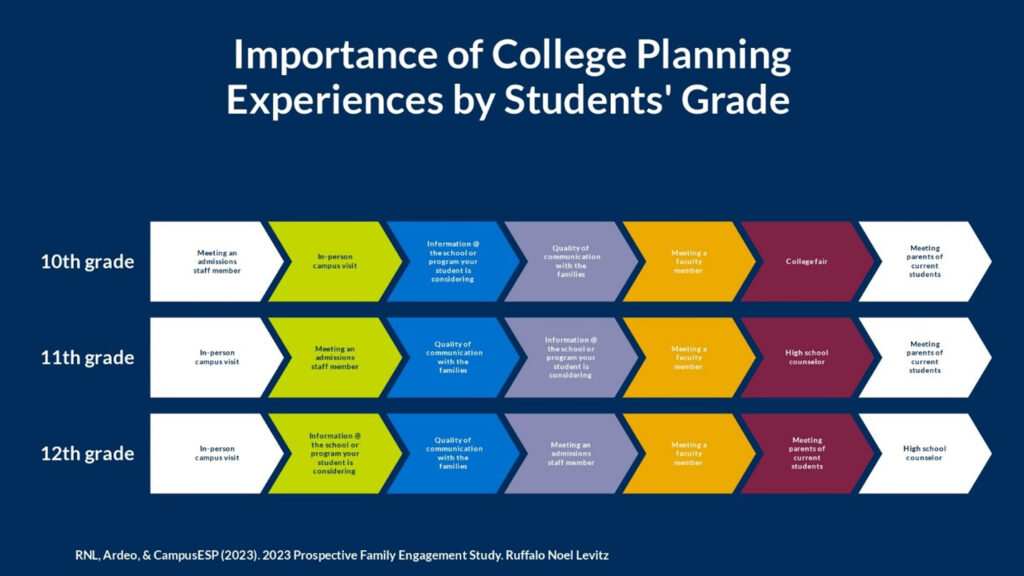enrollment
Prospective Family Communication: Meeting Families Where They Are in Their Enrollment Journey
High school years are some of the most challenging times for families. Grades, curfew, dating, piercings, and choice of friends are among the most stressful issues families and their teens must navigate. On top of that, there is a key topic that occupies families from the start of high school to graduation—college planning!
Teenagers also change dramatically physically, emotionally, and academically from entering high school to graduation. Their relationship with their parents also changes in that time, which means students and their families are not in the same place, mentally and emotionally, in 9th grade as they are during 12th grade. This applies to their college planning behaviors, communication preferences, and needs.
How do you communicate with students and families effectively in light of the changes they go through during high school? Findings from our 2023 Prospective Family Engagement Report shed some light on best practices for communicating with families at different grade levels in high school.
Families want to hear from colleges and universities frequently
The Prospective Family Engagement Report found that 88 percent of all prospective families are open to hearing from institutions at least once a week or whenever they have information to share. This frequency actually increased slightly from our 2022 study.
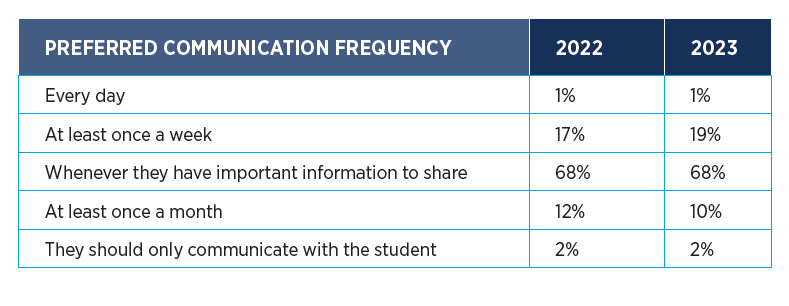
How often they want to hear from institutions depends on their students’ high school grades. Nearly a quarter of families with students in 12th grade responded at least once a week, while 10 percent of 10th-grade families and 9 percent of 11th-grade families chose the same. The key frequency seems to be “whenever they have something important to communicate”, with 68 percent of all families choosing that option.
One theme is running through their responses to this question—families with students in 12th grade are more likely to want to hear from institutions more often than those with students in 10th and 11th grade, which makes sense. We know from other RNL research that parents are more involved later in the process once students narrow down their choices and start getting more “serious” about where they will apply, what colleges they will visit, and so on.
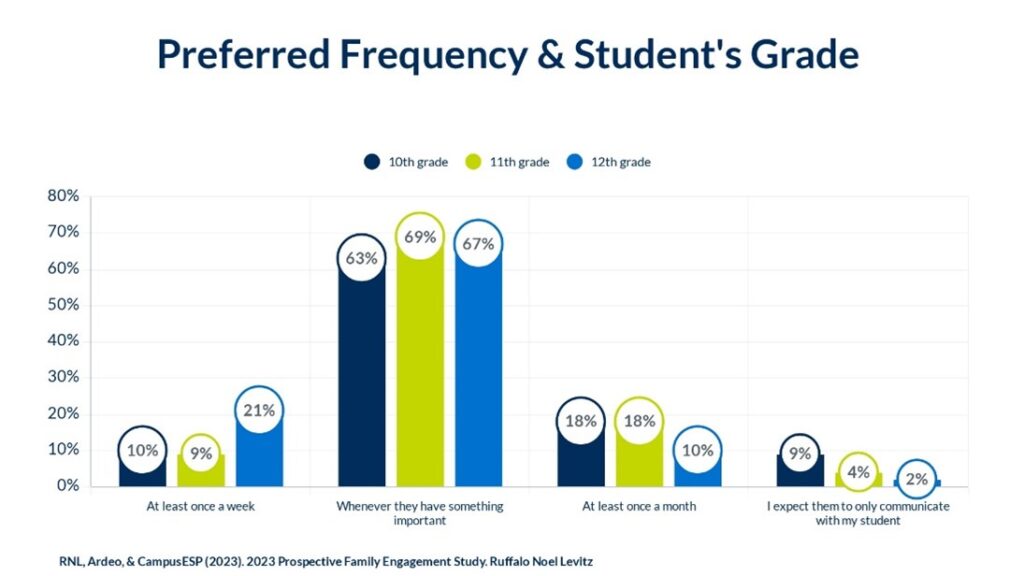
What do prospective families want to know?
Here are the top ten topics they are interested in learning more about.
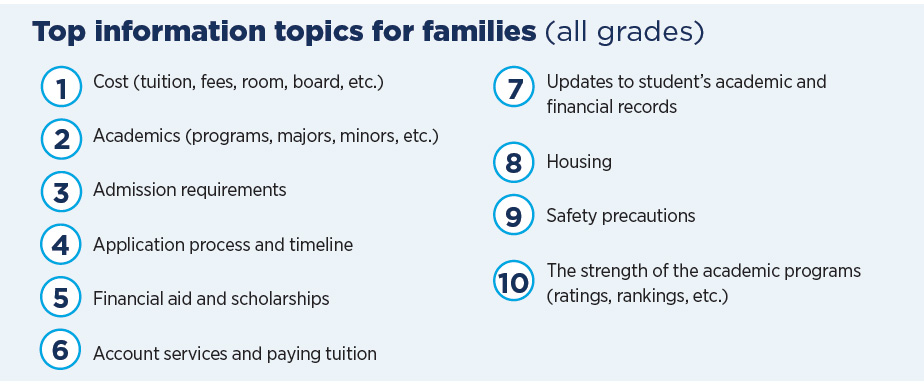
Again, the grade level of the student appears to be a factor in the top information topics families want to receive.

Remember that 12th grade is a critical year for students and families and that the connection between college planning and college life is becoming more of a reality; many questions and concerns will start popping up for the parents and students. Not every student is excited about all the changes and experiences that will happen in college. Most will get there, but during that last year, emotions will be going up and down, and parents need help to guide and help their students.
What are their preferred channels?
- Email 93%
- Direct mail 36%
- Text message 27%
- Family portal 24%
- Telephone 4%
- Apps specific to institutions 3
Again, the student’s grade (age) seems to be a factor in the families’ channel preferences.
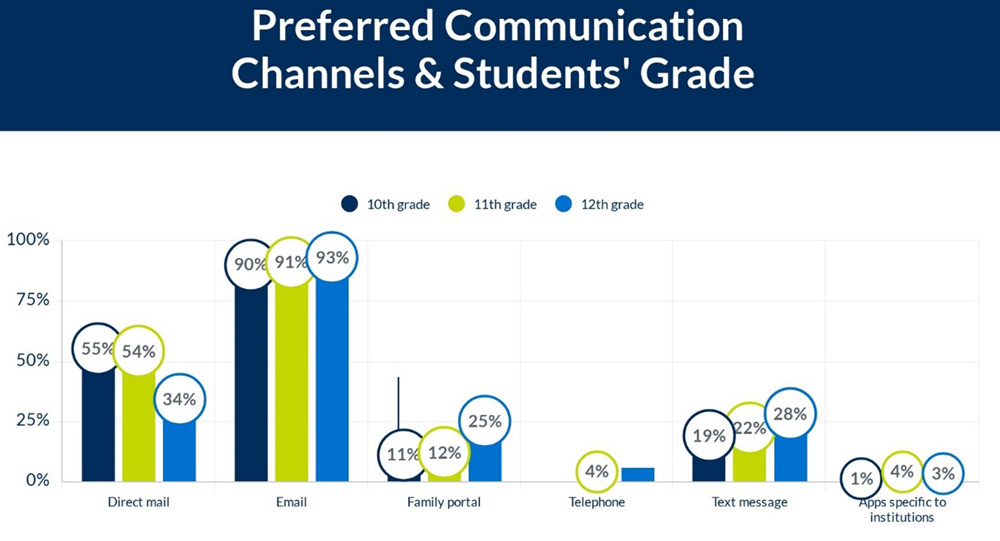
If families’ preferences for channel, frequency, and communication topics are related to their students’ grades in high school, it should not be surprising that the importance of college planning experiences should also vary.
How can you meet these changing needs of prospective families throughout the college search process?
- Keep in mind what families want to know and when. Have all those items available on your website for them to discover they are ready.
- Invite families to ask questions by providing contact information and ensuring all questions are answered in a timely manner.
- Invite families to participate in college planning experiences early on, and always follow up.
- Make information free of admissions jargon and accessible.
Finally, remember that, similarly to students, families are diverse and have a variety of priorities, needs, and expectations. Even when we look at 10th-grade families, their needs, experiences, and challenges differ significantly. Their income, their first-generation status, where they live, where they are from, how long they have been living in the US, and their first language are all factors that will put them in a different spot. All we can do is meet them where they are. Provide information that’s clear, simple, and well-crafted. Remember, they are not just out shopping; they are helping their students choose a college, possibly the most important, expensive, and emotional thing they have done since their children were born.
Read our full report or reach out to talk with our enrollment experts
I encourage you to read the 2023 Prospective Family Engagement Report and explore even more findings. We can also help you engage students and families more effectively, no matter where they are on their college journey. Ask for a complimentary consultation with our enrollment experts and we will set up a time to talk.
What’s your best communication strategy? Let’s talk.
How can you engage prospective students and families? Talk with our enrollment experts and find out how you can provide the information they need to get excited about your institution and move toward enrolling.
